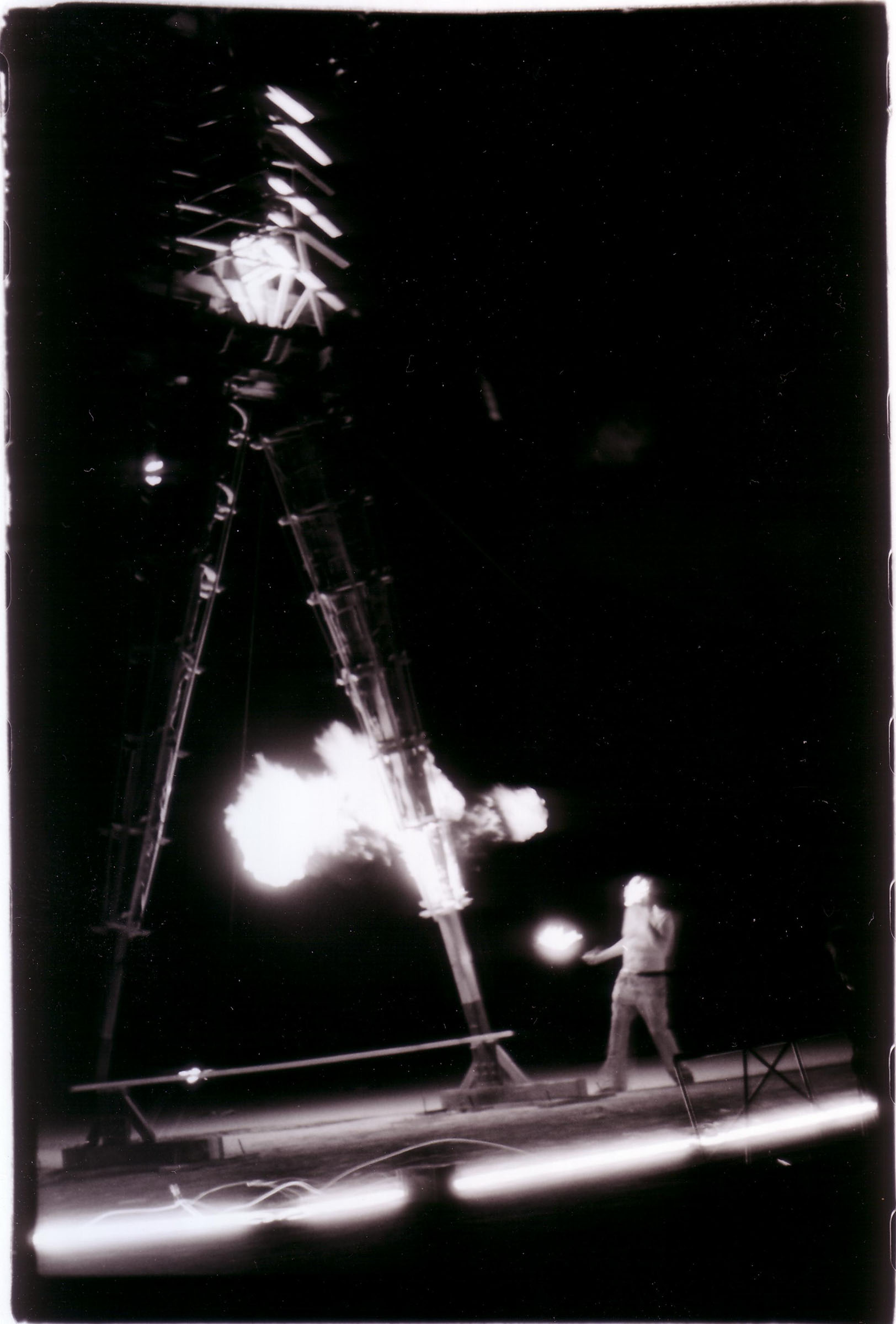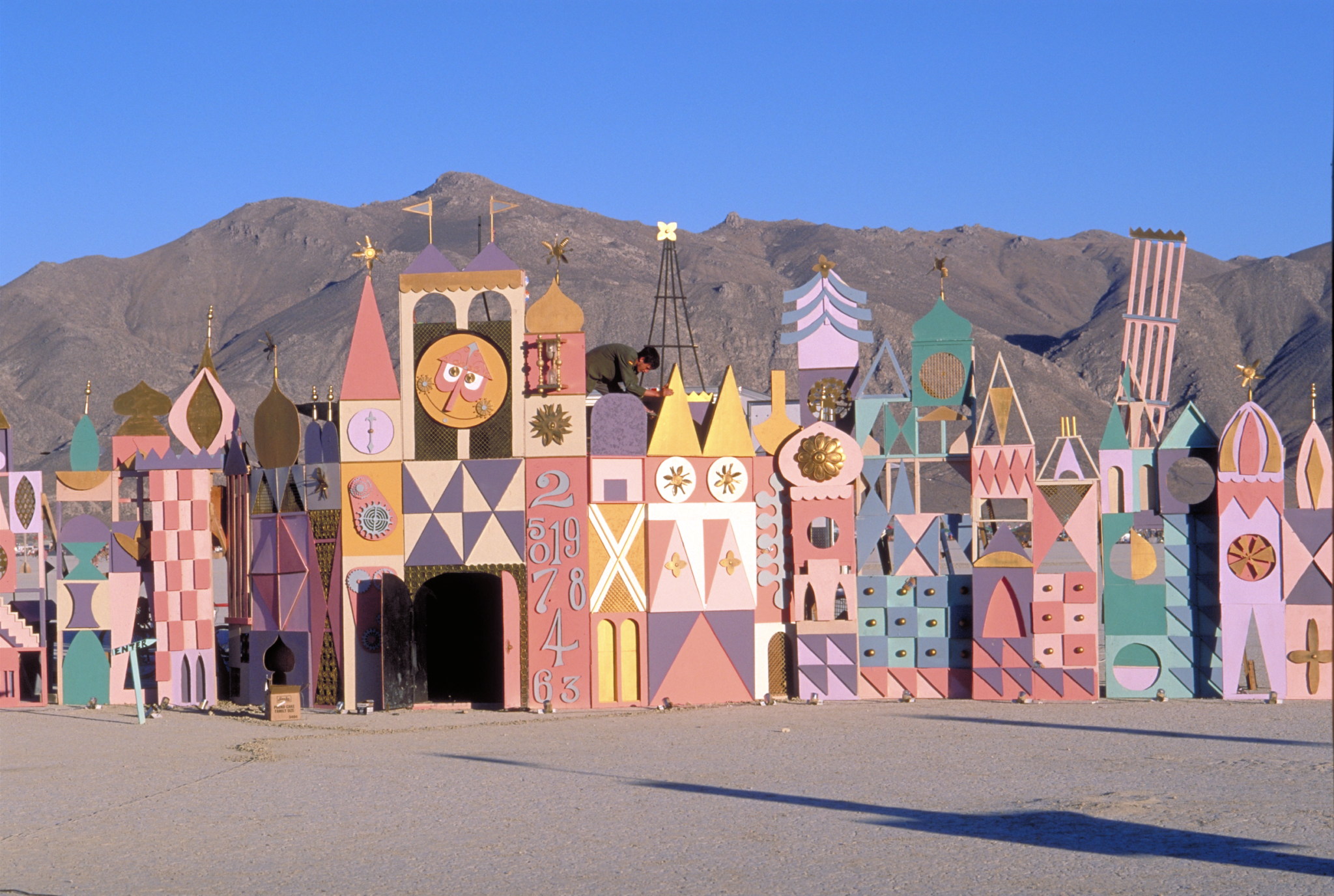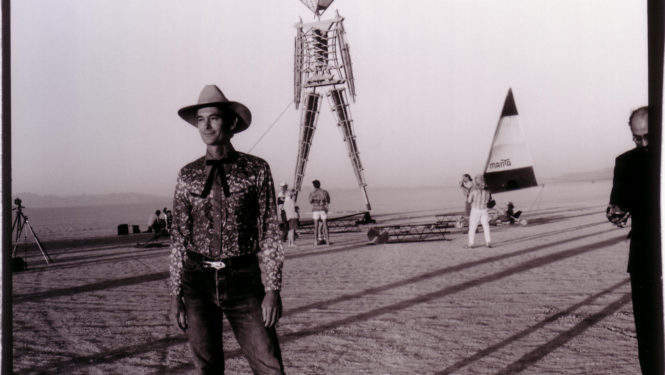Welcome to the final story in a three-part series that unpacks how our 2021 theme — The Great Unknown — summons Burning Man’s origin story. Long before the Man touched down (and burned up) in the Black Rock Desert, the Cacophony Society and its early Zone Trips defined Burning Man’s irreverent spirit. You can now read all three of the published episodes on the Into the Zone series page.
How did we get here? From a place apart where 90-or-so Cacophonists could discreetly raise and burn Larry Harvey’s wooden statue, to the 80,000-something whatever-you-dream-it-to-be extravaganza we’ve experienced in recent years?
How did the momentum and fame of Black Rock City impact the Cacophony Society and subsequent Zone Trips? Can we still cross the line into The Zone, where everything will be different, and maybe find our deepest desires? Maybe.
Just like the three travelers in Tarkovsky’s film Stalker, none of us can go backwards, only forward into a constantly shifting landscape of our own imaginings.

We asked Mikel and Mangrum:
How did being in the Black Rock Desert change the Zone Trip?
Mikel: That’s kind of a broad and leading question. I don’t know that it changed. It was right in the vein of the Zone Trip. What happened as Burning Man grew, it changed. For Cacophony, Burning Man became the thing after a few years; it was the thing to do. And it began to use more and more energy of the Cacophonists who were involved, until it became just about the only thing. The Cacophony Society ran until about 2000. And then basically we stopped publishing, and dissolved, in effect.
A lot of things have grown from Cacophony. There are events that are ongoing, that have morphed into their own thing. There’s the Urban Iditarod, where you push shopping carts through a bar crawl. There’s the SantaCon, the Santa rampage. I was involved with the first one of those, that was a Cacophony event. And boy, did that get out of control.
So Burning Man changed Cacophony, where it became the thing we do. The concept of the Zone Trip, this is still the same thing. There are a lot of urban exploration things that happen all the time, a lot of performance art. But what Cacophony brought to Burning Man as a Zone Trip was the idea of going to a place apart.
This is in effect a pilgrimage. You’re going away, you’re leaving the comfortable place you are, and going to a very unique environment. You’re in effect crossing a ritual line to be in that place that’s different.
Mangrum: I think the better question is “how did Burning Man change Cacophony?” Because it didn’t take long for the Cacophony Society to fade away after merging with Burning Man. In a sense, Burning Man was the child that devoured its parent. How did that happen? I think it may have been that, along with resetting their expectations about place, a lot of people changed how they thought about themselves. They stepped across that line, and they turned around, and there was no path back to where they had been before.

When you participated in Black Rock City in recent years, can you still find and feel that Cacophony spirit?
Mikel: You would have to ask that question to a lot of people. The spirit is there. There certainly is the costuming and the absurdity. Absurdity was a key element in so many things that we did. The idea is to take the mind and to give it a little twist or jog. This enables people to see things differently, to often challenge their concepts of reality itself. And that was a basic premise of Cacophony. So that’s still there.
Mangrum: You know, on the one hand, there’s always something that will surprise me, which is kind of why I keep going. But the serendipitous moments are fewer and further between. So I think this year we need to go back to The Zone. I really do. I think that it’s time for us to put aside our notions of what it’s supposed to be, and what experience we’re supposed to have, and just go into it with beginner’s mind again, like we were on a Zone Trip, and see what we might’ve been missing.
In the 2021 theme announcement, Mangrum writes:
“Quarantine has led us to rethink the very meaning of place, and rid us of certain illusions about it — like the notion that our city was always there somehow, always a certain way, which was never true at all. It was always a figment of our collective imaginations, and fundamentally different each and every year.”

What does it mean to embark on a year that is, in effect, a tabula rasa of unimagined possibilities? Mikel has some thoughts on why Burners are optimally situated to gracefully step into a place apart and welcome whatever it may bring.
Looking at the 2021 theme — The Great Unknown — how is the concept of the Zone Trip relevant to what we are experiencing today?
Mikel: In view of what has happened and is happening in the world? The whole world is going into uncharted territory. I mean, we are planet-wide going into a place that has changed and that place is different. I have a great deal of concern about what that means. There are a lot of factors changing our world. It’s not just COVID, but it’s our technology. It’s the internet. It’s the way that we communicate. These are all things that are now raining down upon us.
And the very ground that we stand on has become unsure. So we’re going to that realm of an unknown land. And I think what Burning Man has and can do is to equip people with the mental tools to exist and thrive in that kind of environment.
Continue your journey into The Zone by reading (or re-reading) the first two episodes in this Journal series:
Cover image of Michael Mikel (aka Danger Ranger), 1990 (Photo by Judy Kokura)


Reminder: Burning Man Project has a responsibility to maintain this space for the benefit of all participants, to ensure that comments serve to enhance the experience of our visitors, rather than cause harm. While spirited conversation is welcome, unruly and rude behavior is not. Posts that are harmful to others or run counter to the spirit of civil discourse may be removed.
Please review our COMMENT POLICY here, then comment with care: https://journal.burningman.org/comment-policy/
Report comment
Though there are certainly some aspects of the original Temporary Autonomous Zones left, costuming and absurdity were mentioned. I think the true indicator is if participants can do whatever they want as long as it doesn’t hinder others from doing the same. This is the backbone of anarchist philosophy. Is that still present? I have certainly done things on the playa that would get me arrested in a default city, and wasn’t arrested.
However, just the presence of Thin Blue Line Camp and the thousands of uniformed and un-uniformed law enforcement types looking to force participants to follow victimless crime laws …well? And then there’s the regulations, no functional sail equipped vehicles, no pets, no firearms, etc… I would have to say that The Burn is just the empty packaging of what it once was, but it’s still better than Defaultia.
Thanks again for this wonderful series, and opening individuals minds to the anarchist/absurdist/dadaist roots of what we all love.
Report comment
You’re SO welcome <3
Report comment
After watching « Stalker » by Andrei Tarkovsky last night the concept of Temporary Autonomous Zones feels fresh and alive. Maybe the Greeters can draw a line on the dusty ground and explain to ALL Burners new and old that they are now entering into one. I think if we all go into Black Rock City with an explorer’s mindset, it will all make so much more sense, even if a lot of that sense is so called nonsense! For some reason my mind keeps reading « uniformed » as « un-informed ». Remember, even the law enforcement officers are in the Zone, this out of their normal element, and are probably learning a lot by being there too.
Report comment
>…but it’s still better than Defaultia.
Disneyland is better than Defaultia. Pretty much any vacation that doesn’t go terribly wrong is, also. But is it worth the price?
Report comment
Before Cacophony Society was the Suicide Club. These groups happened before I learned about them, although I did get to see what would be technically Cacophony Society events.
I had a good friend who was part of the original 80 at the first Black Rock desert Burning Man. He told me stories of the Suicide Club, the motto was Live everyday as if it were your last day. I believe that my friend is present in the top picture above, half of him is in the frame on the right side.
Report comment
It was a pretty small group of us the first year on the playa and most knew each other. That looks to me to be either Bob Gridley or Louis Brill. Of course, that’s Larry Harvey in the hat (joking… M2 :) and David Warren (a Suicide Cluber) breathing fire immolating the man and almost himself.
Report comment
Comments are closed.